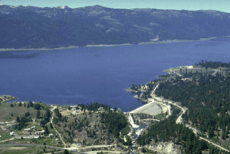Lake Cascade facts for kids
Quick facts for kids Cascade Dam |
|
|---|---|

Cascade Dam
|
|
|
Location in the United States
|
|
| Country | United States |
| Location | Valley County, Idaho |
| Coordinates | 44°31′26″N 116°03′04″W / 44.524°N 116.051°W |
| Purpose | Water storage |
| Construction began | 1942, 1946 |
| Opening date | 1948 |
| Owner(s) | U.S. Bureau of Reclamation |
| Dam and spillways | |
| Type of dam | Zoned earthfill |
| Impounds | N. Fork Payette River |
| Height | 107 ft (33 m) |
| Length | 785 ft (239 m) |
| Width (base) | 45 ft (14 m) |
| Reservoir | |
| Creates | Lake Cascade |
| Total capacity | 693,100 acre-feet (854,900,000 m3) |
| Catchment area | 620 sq mi (1,610 km2). |
| Surface area | 47 sq mi (122 km2) |
| Normal elevation | 4,828 ft (1,472 m) |
Lake Cascade, once called Cascade Reservoir, is a large lake in the western United States. You can find it in Idaho, specifically in Valley County. The lake is part of the Boise National Forest. It covers about 47 square miles, making it the fourth biggest lake or reservoir in Idaho!
The lake was created by building an earthen dam. Construction started in 1942 but was paused because of World War II. Work began again in 1946, and the dam was finished in 1948. The name "Lake Cascade" became popular in the 1990s, and it officially changed in 1999. The closest towns are Cascade, Donnelly, and McCall.
Fun at Lake Cascade
Lake Cascade is a great place for outdoor activities! Many people enjoy fishing here. The lake is home to different kinds of fish like perch, trout, smallmouth bass, and salmon. In the winter, when the lake freezes over, it's a popular spot for ice fishing.
You can also visit Lake Cascade State Park. This park has several areas around the lake where you can camp, boat, and enjoy nature. It's a perfect spot for families and friends to spend time outdoors.
Keeping the Fish Healthy
Sometimes, lakes need help to keep their fish populations strong. In 2003, the Idaho Department of Fish and Game (IDFG) looked into ways to improve the number of popular sport fish in Lake Cascade. They noticed that certain fish, like pikeminnows, were eating a lot of the food that other fish needed.
One idea was to lower the lake's water level to help manage the fish. However, this was a very big and complicated project. It would affect things like water for farms and making electricity. In the end, officials decided that lowering the lake was not the best way to help the sport fish.
Protecting Lake Water Quality
Have you ever seen a lake turn green? This can happen when there's too much of something called blue-green algae. Lake Cascade had a big algae bloom in 1993. This happened because the water level was low, there was a lot of a nutrient called phosphorus, and the weather was hot.
Scientists started checking the water quality in 1995. They found that high levels of phosphorus were causing the algae problem. So, they created a plan to reduce the phosphorus by 37 percent. By 2003, the lake had 57 percent less phosphorus than it did in 1995! This was thanks to new ways of managing the land around the lake, which helped keep the water clean.
Tamarack Resort
On the west side of Lake Cascade, near the town of Donnelly, you'll find Tamarack Resort. This resort is a popular place for skiing and snowboarding in the winter. In the warmer months, people enjoy mountain biking, hiking, and other activities there.



